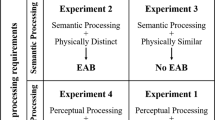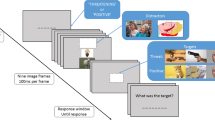Abstract
Simple reaction times (RTs) to acoustic tones were recorded during picture viewing in order to investigate attentional resource allocation to threat stimuli compared with pleasant (sport/adventure) and neutral (household objects) contents. Stimuli were selected as equally arousing according to standardized subjective ratings. In the late stage of picture processing threat pictures showed shorter RTs compared with neutral and pleasant ones. In a second study, a choice-RT task was employed, and a wider range of both pleasant and unpleasant contents was shown. Results indicated slower RTs when blood/injury and erotic couples were presented, compared with other threat, and with other positive (sport/adventure) scenes. Specifically, erotic couples require a greater amount of attentional resources compared with sport/adventure; the same is true for blood/injury stimuli as compared with threat. Remarkable differences were thus shown in attentional deployment to specific stimulus contents within the same valence category. These differences should be taken into account when using such stimuli to investigate emotional processing.
Similar content being viewed by others
References
Bradley, M. M., Codispoti, M., Cuthbert, B. N., & Lang, P. J. (2001). Emotion and motivation I: Defensive and appetitive reactions in picture processing. Emotion, 1, 276–298.
Bradley, M. M., Cuthbert, B. N., & Lang, P. J. (1996). Picture media and emotion: Effects of a sustained affective content. Psychophysiology, 33, 662–670.
Bradley, M. M., Greenwald, M. K., & Hamm, A. O. (1993). Affective picture processing. In N. Birbaumer & A. öhman (Eds.), The structure of emotion (pp. 48–65). Toronto, ON: Hogrefe-Huber.
Cannon, W. B. (1927). The James-Lange theory of emotion: A critical examination and an alternative theory. American Journal of Psychology, 39, 106–124.
Center for the Study of Emotion and Attention (CSEA-NIMH). (1999). The International Affective Picture System: Digitized photographs. Gainesville, FL: The Center for Research in Psychophysiology, University of Florida.
Derryberry, D., & Rothbart, M. K. (1997). Reactive and effortful processes in the organization of temperament. Development and Psychopathology, 9, 633–652.
Derryberry, D., & Tucker, D. M. (1994). Motivating the focus of attention. In P. M. Niedenthal & S. Kitayama (Eds.), The heart's eye. Emotional influences in perception and attention (pp. 167–196). New York: Academic Press.
Foa, E. B., & Kozak, M. J. (1993). The meaning and the structure of fear. In N. Birbaumer & A. öhman (Eds.), The structure of emotion (pp. 110–121). Toronto, ON: Hogrefe-Huber.
Fox, E. (1993). Allocation of visual attention and anxiety. Cognition and Emotion, 7, 207–215.
Greenhouse, S., & Geisser, S. (1959). On methods in the analysis of profile data. Psychometrika, 24, 95–112.
Hampton, C., Purcell, D. G., Bersine, L., Hansen, C. H., & Hansen, R. D. (1989). Probing “pop-out”: Another look at the face-in-the-crowd effect. Bulletin of the Psychonomic Society 27, 563–566.
Hansen, C. H., & Hansen, R. D. (1988). Finding the face in the crowd: An anger superiority effect. Journal of Personality and Social Psychology, 54, 917–924.
Hansen, C. H., & Hansen, R. D. (1994). Automatic emotion: Attention and facial efference. In P. M. Niedenthal & S. Kitayama (Eds.), The heart's eye. Emotional influences in perception and attention (pp. 217–243). New York: Academic Press.
Junghöfer, M., Bradley, M. M., Elbert, T. R., & Lang, P. J. (2001). Fleeting images: A new look at early emotion discrimination. Psychophysiology, 22, 545–560.
Klorman, R., Weissberg, R. P., & Wiesenfeld, A. R. (1977). Individual differences in fear and autonomic reactions to affective stimulation. Psychophysiology, 14, 45–51.
Lacey, J. I., & Lacey, B. C. (1970). Some autonomic–central nervous system interrelationships. In P. Black (Ed.), Physiological correlates of human emotion (pp. 205–227). New York: Academic Press.
Lang, P. J., Bradley, M. M., & Cuthbert, B. N. (1997). Motivated attention: Affect, activation and action. In P. Lang, R. F. Simons, & M. Balaban (Eds.), Attention and orienting: Sensory and motivational processes (pp. 97–134). Hillsdale, NJ: Erlbaum.
Lang, P. J., Bradley, M. M., & Cuthbert, B. N. (1999). International Affective Picture System (IAPS): Technical Manual and Affective Ratings. Gainesville, FL: The Center for Research in Psychophysiology, University of Florida.
Lang, P. J., Greenwald, M. K., Bradley, M. M., & Hamm, A. O. (1993). Looking at pictures: Affective, facial, visceral, and behavioural reactions. Psychophysiology, 30, 261–273.
Mathews, A., May, J., Mogg, K., & Eysenck, M. (1990). Attentional bias in anxiety: Selective search or defective filtering? Journal of Abnormal Psychology, 99, 166–173.
Mathews, A., & McLeod, C. (1986). Discrimination of threat cues without awareness in anxiety states. Journal of Abnormal Psychology, 95, 131–138.
McNally, R. J., Riemann, B. C., & Kim, E. (1990). Selective processing of threat cues in panic disorder. Behaviour Research and Therapy, 28, 407–412.
Mogg, K., Mathews, A., & Eysenck, M. (1992). Attentional bias to threat in clinical anxiety states. Cognition and Emotion, 6, 149–159.
Mogg, K., Mathews, A., Eysenck, M., & May, J. (1991). Biased cognitive operations in anxiety: Artefact, processing priorities or attentional search? Behaviour Research and Therapy, 29, 459–467.
Mogg, K., Mathews, A., & Weinman, J. (1989). Selective processing of threat cues in anxiety states: A replication. Behaviour Research and Therapy, 27, 317–323.
Nothdurft, H. C. (1993). Faces and facial expressions do not pop out. Perception, 22, 1287–1298.
öhman, A. (1986). Face the beast and fear the face: Animal and social fears as prototypes for evolutionary analyses of emotion. Psychophysiology, 23, 123–145.
öhman, A. (1997). As fast as the blink of an eye: Evolutionary preparedness for preattentive processing of threat. In P. J. Lang, R. F. Simons, & M. T. Balaban (Eds.), Attention and orienting: Sensory and motivational processing (pp. 1–27). Hillsdale, NJ: Erlbaum.
öhman, A., & Soares J. J. F. (1993). On the automatic nature of phobic fear: Conditioned electrodermal responses to masked fear-relevant stimuli. Journal of Abnormal Psychology, 102, 121–132.
Palomba, D., Sarlo, M., Angrilli, A., Mini, A., & Stegagno, L. (2000). Cardiac responses associated with affective processing of unpleasant film stimuli. International Journal of Psychophysiology, 36, 45–57.
Plutchik, R. (1970). Emotions, evolution, and adaptive processes. In M. Arnold (Ed.), Feelings and emotions: The Loyola Symposium. New York: Academic Press.
Posner, M. I. (1978). Chronometric explorations of mind. Potomac, MD: Erlbaum.
Purcell, D. G., Stewart, A. L., & Skov, R. B. (1996). It takes a confounded face to pop out of a crowd. Perception, 25, 1091–1108.
Rachman, S. (1998). Anxiety. In C. R. Brewin (Ed.), Clinical psychology: A modular course. Hove, U.K.: Psychology Press.
Riglis, E. (1998). Modeling visual complexity in image architectures. PhD First Year Report, Edinburgh, U.K.: Heriot-Watt University.
Sarlo, M., Codispoti, M., Palomba, D., Angrilli, A., & Stegagno, L. (1997). Danger! Attention in emotional contexts. Poster presented at the AIP/EPS Meeting, Cardiff, U.K., July 2–4.
Schneider, W. (1988). Micro Experimental Laboratory. An integrated system for IBM-PC compatibles. Behavior Research Methods, Instrumentation, and Computer, 20, 206–217.
Soares, J. J. F., & öhman, A. (1993). Preattentive processing, preparedness and phobias: Effects of instruction on conditioned electrodermal responses to masked and non-masked fear-relevant stimuli. Behaviour Research and Therapy, 31, 87–95.
Watts, F. N., McKenna, F. P., Sharrock, R., & Trezise, L. (1986). Colour naming of phobia-related words. British Journal of Psychology, 77, 97–108.
Wertheimer, M. (1939). Laws of organization in perceptual forms. In W. D. Ellis (Ed.), A Sourcebook of Gestalt Psychology (pp. 331–363). New York: Harcourt, Brace and Co.
White, M. (1995). Preattentive analysis of facial expressions of emotions. Cognition and Emotion, 9, 439–460.
Wolpe, J., & Lang, P. J. (1964). A fear survey schedule for use in behaviour therapy. Behaviour Research and Therapy, 2, 27–30.
Author information
Authors and Affiliations
Rights and permissions
About this article
Cite this article
Buodo, G., Sarlo, M. & Palomba, D. Attentional Resources Measured by Reaction Times Highlight Differences Within Pleasant and Unpleasant, High Arousing Stimuli. Motivation and Emotion 26, 123–138 (2002). https://doi.org/10.1023/A:1019886501965
Issue Date:
DOI: https://doi.org/10.1023/A:1019886501965




